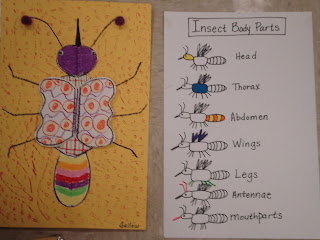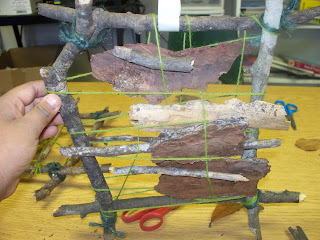After collecting leaves of various shapes and sizes from the school grounds, I discussed with my first grade art students why leaves change colors and fall off the trees in the fall. I used the example of the tree being a mama who grows weary and tired when winter nears. She needs to rest- she has been working hard all year to feed and nourish all her baby leaves. So, being like most mamas who need to rest, she shakes her babies from her limbs and tells them that they need to get off her, she needs some time to rest. I asked the students if their mamas ever said that to them, and the answer was a resounding "YES!" The analogy just came to me when I started talking about the leaves, because like most things in my life, I relate to my parenthood. I told the students that after the mama starts to rest and can't feed her babies anymore, making them green, that's when the colors that were always in them begin to appear. We talked about how water, sun and chlorophyll all play their part in making the leaves green. The art lesson began with science, and ended with coloring and painting.
Placing the leaves underneath their watercolor paper, the students used rubbing crayons to rub on top of the paper and make their leaves appear- this never fails to make them "Ooooh and Ahhhh!" It's like magic! Then, using a warm color palette, the students painted in their leaves with watercolors and washed their backgrounds with cool colors. This was a one part lesson with beautiful results.
Search Creating Art
Wednesday, October 27, 2010
Monday, October 25, 2010
Martha Graham to Agnes de Mille...
"There is a vitality, a lifeforce, an energy, a quickening that is translated through you into action, and because there is only one of you in all of time, this expression is unique. And if you block it, it will never exist through any other medium and it will be lost. The world will not have it. It is your business to keep it yours clearly and directly, to keep the channel open. You do not even have to believe in yourself or your work. You have to keep yourself open and aware of the urges that motivate you. Keep the channel open... No artist is pleased (there is) no satisfaction what(so)ever at any time. There is only a queer divine dissatisfaction, a blessed unrest that keeps us marching and makes us more alive than the others."
Thursday, October 21, 2010
GIANT CROCS!
2nd grade students created these Giant Crocs! Elementary age students (I can only speak for them) have a very hard time drawing BIG. This project was the perfect subject to teach them how to draw on a large scale- I told them, "I don't wanna see any itty bitty little crocodiles! Crocodiles are BIG! So fill up your whole paper!"
We watched a Power Point presentation I created on crocodiles, with lots of pictures and factual information. We discussed the texture of the crocodiles skin and the lines we would use to draw the crocs.
Then, using a large piece of green craft paper, we drew them step-by-step. Once they were drawn in pencil, students outlined them in black permanent marker. Next, we added texture to the crocodiles skin by using rubbing crayons and texture cards. Students colored in the teeth and eyeballs with white crayons and cut their crocs out.The final step was to make an environment for our crocodiles. We learned that they live in the water and find their prey on the banks of the water. So, on a large piece of cardboard, approx. 12" x 28", we collaged water and a sandy bank. This was the most fun project! The students liked making our BIG art project and they named all of their crocs!
Friday, October 15, 2010
Symmetrical Insects
Teacher Example
First graders learned about insects and their body parts in art. We talked about how an insects body is the same on both sides and the word for that is symmetry. Then we drew half of our insects' body on a long, folded sheet of paper along the creased edge. The students traced their pencil lines with black crayon and folded the blank side of their paper on top of their drawing. They printed their black lines on the other side of their paper by rubbing over their folded paper with a craft stick. Students then traced over their printed lines again with black crayon. Now they were ready to decorate their insects with bright, colorful patterns! They colored in the head, thorax and abdomen, then cut out their insects' body. Each student made a decorated paper to glue their insects on, drew in the antennae, mouthparts and legs, created wings and glued them on, and added googly eyes and pom poms to end of their antennaes for the final touch. The students had so much fun creating their insects! They did a fantastic job! Here are some examples:
Thursday, October 14, 2010
Optical Illusions
Fifth graders learned about Optical Illusions. We created these simple designs, by dividing our paper into eight sections and drawing lines that curved in opposite directions in each section. Students then created a color pattern within their "stripes" and shaded the outside edges of their stripes, to create the illusion of the sections curving outward.
Radial Designs
Fourth Graders learned about radial designs- any type of balanced design based on a circle. We looked at rose windows and mandalas for inspiration, learning about this ancient art form. To make their own radial designs, we used a printing technique which made it easier for the student s to create a balanced design.
First, we created a section of the circle by folding a 6" square on the diagonal and cutting off the top of the paper, through both layers, to create a "pizza wedge". Then, on one side of the pizza wedge, students drew simple lines and shapes to create a design. They traced their design with an oil pastel, folded the other side of the pizza wedge on top of their drawing, and printed it onto both sides of the paper. They traced over the printed design again with the oil pastel. Once they were ready to print the design onto a larger piece of paper, the students werte given a 12" square of white drawing paper and folded it in half twice. This made a vertical and a horizontal line going throught the center of the paper which they would use as their guide for printing their design. They placed their design wedge, pastel side down, onto their paper and transfered onto the paper using the side of a large craft stick. Students then rotated their design around the center axis, printing in all four sections of the paper. Once their design was completely printed onto their large paper, they traced it with a black sharpie, colored it in with crayons and went on top of their crayon work with watercolor markers. The result were beautiful, stained glass looking radial designs.
First, we created a section of the circle by folding a 6" square on the diagonal and cutting off the top of the paper, through both layers, to create a "pizza wedge". Then, on one side of the pizza wedge, students drew simple lines and shapes to create a design. They traced their design with an oil pastel, folded the other side of the pizza wedge on top of their drawing, and printed it onto both sides of the paper. They traced over the printed design again with the oil pastel. Once they were ready to print the design onto a larger piece of paper, the students werte given a 12" square of white drawing paper and folded it in half twice. This made a vertical and a horizontal line going throught the center of the paper which they would use as their guide for printing their design. They placed their design wedge, pastel side down, onto their paper and transfered onto the paper using the side of a large craft stick. Students then rotated their design around the center axis, printing in all four sections of the paper. Once their design was completely printed onto their large paper, they traced it with a black sharpie, colored it in with crayons and went on top of their crayon work with watercolor markers. The result were beautiful, stained glass looking radial designs.
Nature Weavings
My third grade students made these beautiful nature weavings. It has been beautiful weather here the last couple of weeks, a perfect time to take our art outdoors! First, we made a frame out of sticks, hotgluing the sticks in place. The corners were then reinforced with twine. Then, the students created their loom by wrapping yarn around their frame vertically and horizontally. Once their loom was made, we went outside and collected natural objects for our weaving. The weaving pictured above makes me smile huge when I see it; the student proclaimed after placing the yellow leaf in it, "Look! The yellow leaf gave it spirit!"
Labels:
3rd Grade,
Nature Weavings,
Recyclable Art,
Weavings
Subscribe to:
Comments (Atom)


























